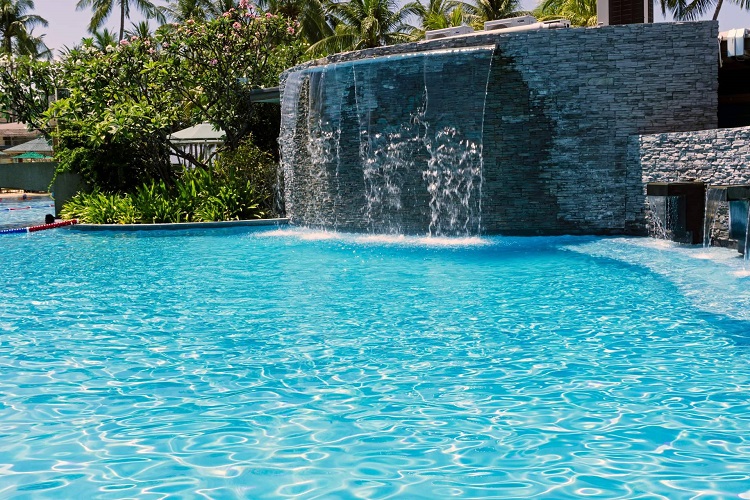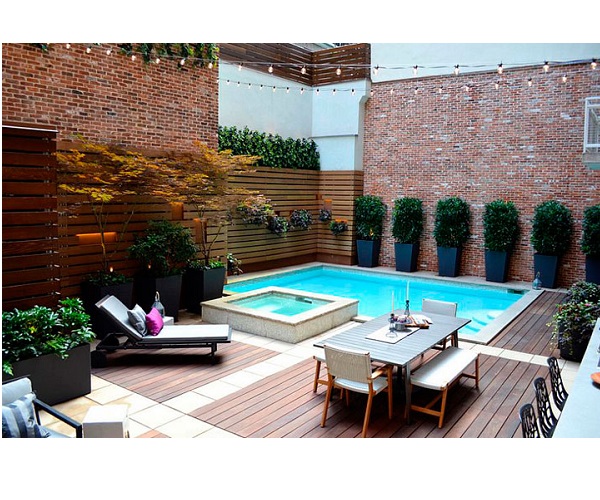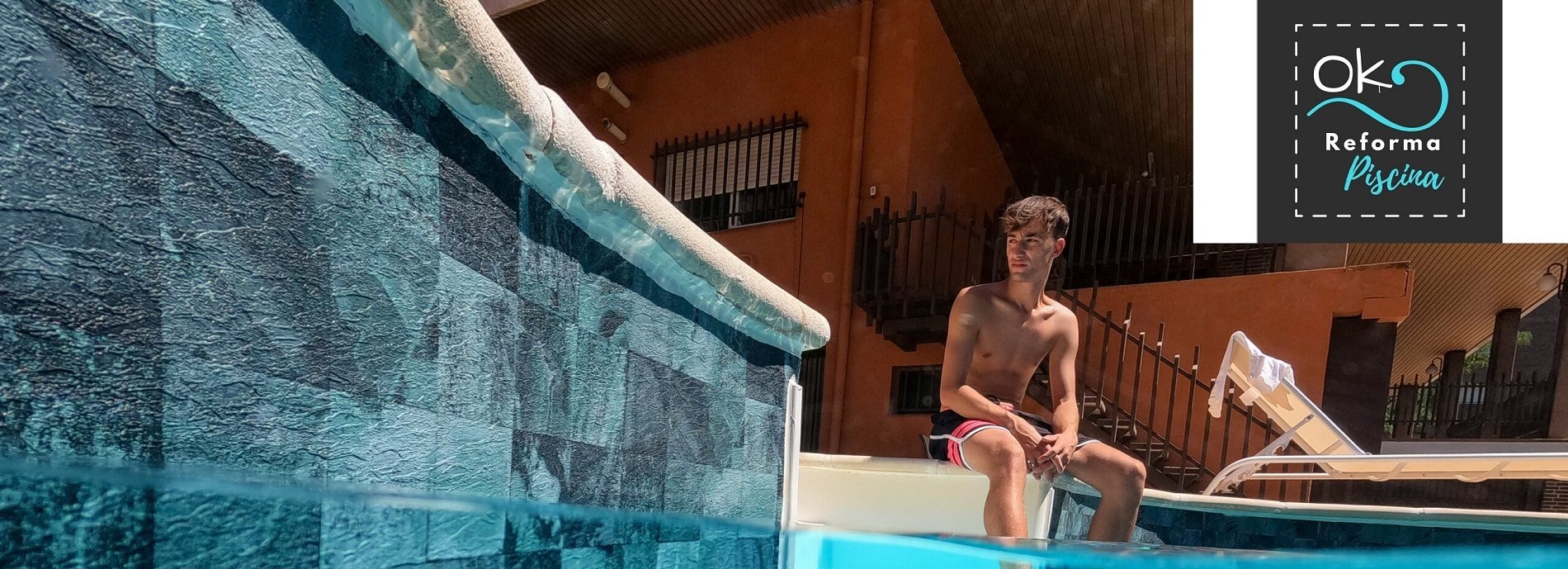
Table of contents of the page
To get started, on this page of Ok Pool Reform within Pool Designs we want to talk to you about the Characteristics of a stone waterfall for a natural pool.
Get a design with prestige: stone waterfall for pool

A pool with a stone waterfall is an attractive, natural-looking addition to any garden.
The first step in creating a stone waterfall pool is choosing and installing the right type of stone for the project.

Types of accessories and glass material for the pool

Trends and factors to consider in pool and garden designs
Natural rock pools are a popular choice among homeowners looking to create an oasis in their yard.
- To start, waterfalls with natural rock pools are a very popular option among homeowners looking to create an oasis in their garden.
- Additionally, its beautiful, natural look and the soothing sound of cascading water can transform any pool into a tranquil retreat you'll love to spend time in.
What should you consider before purchasing natural stone pools with waterfalls?

Previous reflections before buying swimming pools with natural stone waterfalls
If you are interested in adding a natural rock waterfall to your pool, there are several things to consider before you get started.
- One of the first considerations is whether you want your waterfall to be “cascading” or “flowing.” Although both types will help differentiate your pool from others, they produce different sounds and noise levels when water flows over them. This way, a waterfall will have a louder sound if you install it in an in-ground pool plagiarizing the flow of water from the sound of nature.
- Likewise, logically, a natural rock waterfall adds visual appeal and sound to your pool, mention that the rocks used are usually stone or slate.
- Of course, one of the most important considerations is where in the pool it will be placed. If you have an in-ground pool, it is easier to add a natural rock waterfall because your pool has been excavated and there is more room to work with. On the other hand, if you have an above-ground pool or an in-ground pool that was created without much space around it, you may need to hire someone who can come up with creative solutions to place a natural rock waterfall in your pool.
- Darker colors will make your waterfall look more natural, while lighter colors can make it stand out more, meaning waterfalls that use dark or slate rocks stand out more and give your pool a more natural feel.
- You can choose the size and shape of the rock you use based on how big or small you want your waterfall to be. Although, it is best to choose pieces that fit together naturally, but if you feel like giving it an extra touch, you can paint each piece a different color so that they stand out when seen together
- It's best to choose pieces that fit together naturally, but if you feel like giving it an extra touch, you can paint each piece a different color so they stand out when seen together.
- Once you have chosen where in the pool you are going to place the.
- However, if you want your waterfall to stand out, you can paint the rocks different colors so that when viewed together, they create a pattern.
Advantages Natural Rock Pool Waterfalls

Benefits Natural Rock Pool Waterfalls
Below we clarify all the PROS of natural rock pool waterfalls.
1. Improved aesthetics:
- It is worth mentioning that a beautiful waterfall can make any outdoor space seem more elegant and welcoming, including the pool area. Natural stone waterfalls feature a wide range of colors and textures that help enhance the look of your property as a whole, while creating an oasis atmosphere in which to relax and unwind.
2. Greater privacy –
- On the other hand, many homeowners use their backyard pools as private retreats where they can seek serenity and escape from their busy lives for a few hours a day. A natural stone waterfall not only adds an overall look to the pool area, but also helps create a feeling of tranquility and privacy.
3. Increase in property value:
- Besides that. If you are planning to sell your home in the near future, investing in a natural stone waterfall for your pool is one of the best ways to increase its value. A properly installed waterfall can add up to 15% to the total value of your outdoor space.
4. Reduction of maintenance costs –
- As if that were not enough, installing a natural stone waterfall for your pool not only improves its aesthetics and helps you enjoy more time outdoors, but it also helps reduce the total cost of maintenance and care of your pool area. pool. Made from durable materials that resist stains and fading, these waterfalls require less cleaning and maintenance than other pool items.
As you can see, installing a natural stone waterfall in the pool area has many advantages. Whether you are looking for ways to increase the overall value of your property or simply want to create an attractive and tranquil outdoor space, adding a waterfall is the perfect way to achieve these goals. Talk to a pool design professional about adding a waterfall to your backyard oasis today!
Disadvantages of a pool with a stone waterfall

Cons of natural stone waterfall in your pool
1st Disadvantage of natural rock pool waterfalls: beautiful but can be heavy, opaque and difficult to work with.
- Likewise, installing natural stone waterfalls is a complex process that requires specialized tools and experience.
- For this reason, it is best to hire professional pool builders who have experience installing natural stone waterfalls in both indoor and outdoor pools.
2nd Con: Natural stone waterfalls require regular maintenance to maintain their beauty and functionality.
This maintenance usually consists of cleaning the stones with mild detergents, checking for cracks or other damage, and sealing the waterfall to prevent water from seeping through the joints of the stone.
3rd unfavorable point: Please note that some natural stone waterfall materials discolor if they come into contact with pool chemicals,
- So be sure to talk to a professional at your local pool supply store before making any decisions about what material to use for your project.
4th Disadvantage of natural stone waterfalls: they are also more expensive than other alternative materials, such as concrete or fiberglass.
- However, this cost is offset by the beauty and durability of natural stone.
So, if you are interested in adding a natural stone waterfall to your pool or spa, be sure to work with experienced professionals who can handle the complex installation process and provide ongoing maintenance services. With proper care and maintenance, your natural stone waterfall will provide years of enjoyment to your family and guests.
Most common materials for pool with stone waterfall

Pool material prototypes with stone waterfall
There are many types of stone that can be used for waterfalls: The stone model you choose will depend on your budget and aesthetic preferences.
Each type of stone is slightly different in terms of color, texture and durability.

1st Stone waterfall for pool with quartzite
Characteristics: Quartzite has a characteristic shiny appearance due to its high quartz content.
- Quartzite is a metamorphic rock composed primarily of quartz (a hard mineral) that undergoes heat and pressure over time. As such, it is one of the most durable natural stones available today, resistant not only to extreme temperatures, but also to stains caused by chemicals such as chlorine or other pool cleaning solutions.
- Although quartzite can be quarried in large blocks to create long waterfalls with multiple drops, it is most often used for smaller water features such as garden ponds and spas. Color variations within the stone often create pleasing visual effects that can be further enhanced by the addition of quartzite fountains or other decorative elements.
- Quartzite waterfalls can also be incorporated into existing landscaping elements to enhance their visual appeal. For example, natural stone paths and garden walls can be enriched by adding a small stream or quartzite waterfall that connects them to adjacent pools or gardens.
2nd waterfall pool limestone

The waterfall pool is made of limestone, a type of rock found throughout the world. Limestone is usually light brown or beige in color and has visible fossils embedded in it.
- Calcareous formations can form as layers or festoons and ripple marks on the slopes of underwater mountains (reefs).
- In fact, many underwater mountain ranges are built from calcified corals, mollusks, algae and other marine organisms that have died over time. The sediments created by living beings eventually harden into limestone over thousands or millions of years.

3rd Stone waterfall with polymeric sandstone
Properties Polymeric sandstone
- Sandstone comes in a wide range of colors – from tan to reddish brown to gray – and features layers that form when sediments are deposited between layers of other rocks.
- Additionally, Polymeric Sandstone Due to its highly permeable nature and ability to retain small amounts of water on the surface, Polymeric Sandstone is an attractive option for building a pool waterfall.
- This type of stone also has low maintenance requirements, requiring only periodic cleaning with mild detergents to maintain its durability and freshness.
- However, this material needs additional protection from the elements by placing it under some type of shelter or cover structure during extreme conditions.
- Although, this type of stone may be more expensive than other options and may not last as long in terms of longevity.
4th pool with granite stone waterfall

The granite stone waterfall pool is a very popular water feature in home landscapes and gardens.
- This naturalistic waterfall provides a strong visual element, making this feature perfect for areas that are heavily landscaped or have limited space.
- Granite can be used to create beautiful waterfalls in almost any style of pool. Whether you prefer the classic look of granite with speckled black spots or something more exotic, like swirls of pink and black, it's easy to find the right stone style to make your dreams come true.
- The basic construction of the waterfall is designed around several pieces of granite that are carved into the appropriate shape for your project and held together with silicone or epoxy adhesive. Water flows through the center of these stones, creating a gentle waterfall that is visually relaxing and calming.
5th pool waterfall with natural slate stone

Slate is a type of metamorphic rock with distinct layers that form when sedimentary rocks are heated and compressed.
- Slate pool waterfalls are beautiful: they have smooth, shiny sides and a spectacular waterfall shape. Slate pool waterfalls can be created in several ways. The waterfall can be built directly into the side of the slate pool, so that it exits through an opening in the wall of the pool area. Or, you can use a sheet of slate as an artificial waterfall bench. Whichever method you choose, your slate pool will look even more attractive with its own waterfall
- One thing to keep in mind when choosing a type of slate for your pool is how slippery it can be.
